Land torpedo Wickersham Land Torpedo (USA)
Recall that two French land torpedoes were created in the middle of 1915, but only one of them was put into service. Batch production of such weapons lasted about a year, and then it was curtailed in connection with the preparation for the construction of high-grade armored combat vehicles, which were a more convenient means of breaking through the defenses of the enemy. After that, France refused to develop such ammunition, but soon a similar project was proposed in the United States.
The first land torpedo of the American design was created by the designer Elmer I. Wickersham, at that time an employee of the Holt Manufacturing Company. The main activity of the company was the production of tractors and construction equipment, but a number of its employees also engaged in military projects. For example, with the participation of E.I. Wickersham was created several experimental machines, and even the first full-tank US.
According to known data, Holt’s engineer began designing self-propelled engineering munitions no earlier than 1917. By the autumn of next year, a documentation package was prepared, which allowed to register an interesting invention. In September, 1918, the designer applied for a patent. The US patent number US 1407969 was published at the end of February 1922.
The topic of the received patent looked simple and clear: Land torpedo (Land / Land Torpedo). Given this classification and authorship, the original project received the more complete name of Wickersham Land Torpedo. Other designations are not used.
E.I. Wickersham offered to make a compact and relatively light tracked vehicle electrically. To destroy targets, it was planned to use a high-explosive warhead of a relatively large mass. In terms of its technical appearance, the Holt torpedo was similar to previous French designs, which suggests the borrowing of certain ideas. However, the American designer could do without direct borrowing and use the most obvious solutions that provided a certain similarity to several samples.
The Wickersham Land Torpedo product was supposed to be the most compact tracked cart, most of the units of which did not protrude beyond the belts of the chassis. In addition, the engineering system was supposed to include a small control panel and an external power source that ensured the operation of all systems. The latter was to be chosen in accordance with the wishes and capabilities of the customer, as well as taking into account the mobility of the systems.
The main element of the land torpedo of a new type was a metal frame of relatively complex configuration, assembled from small parts. It was proposed to fix all the main devices on it, from the controls to the warhead. The largest frame elements were four longitudinal beams, which were placed in pairs along the sides of the product. Between them it was proposed to fix the main elements of the chassis. With each other, a pair of beams was fastened with the axles of the wheels and a horizontal platform for mounting the engine. The central beams were longer. At the enlarged and raised rear of these parts were provided for mounting for the cable coil.
Between themselves, a pair of beams were connected with the help of several transverse force elements. At the same time in the stern of the torpedo provided for a more complex design with bevelled parts. The frame shown in the drawings of the patent had a curious feature. All the transverse elements were concentrated in its rear part, while the front ends of the beams, fastened to the guide wheels, were not connected to each other.
E.I. Wickersham offered a curious arrangement of units, which allowed to reduce the dimensions of the product without loss in the main characteristics and capabilities. So, between the tracks it was proposed to place a large and long cylindrical body of the warhead. According to the drawings attached to the patent, the warhead could occupy the space from the axes of the guide wheels to the axes of the leading ones. At the same time, the upper part of the cylinder rose only slightly above the tracks. Directly behind the warhead, on the same level, it was proposed to place a reel for cables.
Wickersham Land Torpedo differed from its location of engines from another tracked vehicle engineering charge. A pair of electric motors of sufficient power, it was decided to install inside the tracks. Their mounts were placed on pads in the central part of the longitudinal beams. The motor shaft was removed back and reached the gearbox. The latter was located directly on the axis of the drive wheel and transmitted torque to it. To avoid contamination or damage to the engines should be covered with light covers. Probably, at the request of the customer, the torpedo propulsion system could receive any reservation.
The chassis of the "Land Torpedo" was fairly simple, but it could fully perform its functions. Four wheels of similar construction were fixed in the front and rear parts of the frame. Sufficiently large wheels consisted of a pair of elements with knitting needles and a serrated rim. In the case of front guide wheels, such parts were loosely mounted on the axle. Details of the drive wheels, in turn, were connected to the gearboxes. The specific proportions of the torpedoes made it possible to do without additional track rollers and distribute the entire weight into four large wheels.
On two wheels, it was proposed to pull a relatively simple track. It was based on a pair of metal chains that meshed with the toothed rims of the wheels. Between themselves the chains were connected by rectangular transverse shoes. The latter allowed to obtain the required width of the support surface and optimize the weight distribution on the ground.
The main task of the land torpedo was the delivery to the target of an engineering demolition charge. The required amount of explosive should be placed in the central cylindrical body. It was proposed to make an explosion using a remote-controlled electric fuse.
An important feature of the Wickersham Land Torpedo product was the lack of an onboard power source. The power supply of two electric motors and the fuse should have been carried out using a remote source of direct current. A generator or a battery with the required characteristics was proposed to be placed on the position of the operator of the complex. The transfer of electricity and, accordingly, the commands had to be carried out by wire.
To communicate with the control panel, self-propelled ammunition had to carry its own long cable. In order to transport and issue it was proposed to use a feeding coil with a spring mechanism. The latter was supposed to compensate for jerks and ensure a smooth winding of the cable, preventing its damage. During the movement of the wire had to be unwound from the coil and lay on the ground. The connection with the console was carried out using three wires of sufficient strength.
The control panel of the complex was distinguished by a rather simple design and was based only on the available components. The controls of the torpedo were a pair of variable resistor knobs, a switch and a switch that determines the mode of operation of the devices. With the help of the latter, the operator of the complex could switch on the movement mode or the detonation mode. From the position of the handle depended the path of current flow.
The control of a pair of electric motors was carried out using two rheostats. Each of them was connected with the "plus" wire of its own motor. The third cable, trailing behind the torpedo, served as a minus. By changing the position of the resistor knobs, it was possible to adjust the engine speed and move forward or perform various maneuvers. For the movement back it was proposed to use a switch that switched the polarity and changed the direction of rotation of the motor shafts.
E.I. Wickersham proposed an original scheme for undermining a warhead that did not need a separate cable line. Having brought the “Ground torpedo” to the target, the operator had to switch the console to the mode of detonation: changing the position of the corresponding switch led to a corresponding reorganization of the circuits. Undermining was carried out when translating the slider of one of the rheostats to the extreme position. In this case, the contact of the slider had to go off the main conductor and apply voltage to the coil. After that, the wire, in the basic mode, which was the “minus”, passed the current, which provided a spark on the warhead fuse. At the same time, the ground itself was the construction of a torpedo.
According to the patent, the land torpedo E.I. Wickersham was supposed to have a combined high-explosive fragmentation effect. Exploding, the charge of the warhead was supposed to create a shock wave, leading to the destruction of the entire product design. The flying elements of the torpedo should have hit the surrounding objects, first of all, manpower and unprotected structures. The formation of such damaging elements could complement the high-explosive action and to some extent increase the overall power of the munition.
An important feature of the original weapon, especially noted by its inventor, was the great simplicity of the design, which made production cheaper. Due to this, the troops could use land torpedoes in large quantities, including at the same time. This made it possible to organize massive attacks on enemy targets or even the creation of mobile mine-blast barriers in the way of moving enemy troops.
Also, the inventor did not rule out the possibility of using the "Land Torpedo" in auxiliary roles. So, instead of a cylindrical body with explosives on the tracked chassis, you could install a lightweight cargo platform. In this configuration, a self-propelled machine with remote control could be used to transport ammunition or evacuate the wounded. The standard cable reel could be used for laying wire lines.
Regardless of the method of application, the Wickersham Land Torpedo product was fairly simple and safe to use. By operating a self-propelled torpedo, the operator of the complex could remain in a safe place, although he needed some means of observation. In certain circumstances, this could make it difficult to track the torpedo, but in any case, the person was not exposed to direct danger.
Approximately in 1918 a year or later, Holt Manufacturing built a prototype of an original land-based crawler-mounted torpedo. There is reason to assume that the prototype, which was intended to conduct ground tests, did not fully comply with the full combat configuration. In particular, the explosive charge could be replaced by a weight simulator. At the same time, an experienced torpedo received some units that were not indicated on the drawings from the patent. For example, the engines inside the tracks are covered with their own protective covers.
Information about the progress and test results of the first experienced Wickersham Land Torpedo are not available. However, it is known that after carrying out some checks the original project was stopped. The reasons for such an outcome could be both in the technical imperfection of the proposed product, and in the lack of prospects, due to the impossibility of obtaining an order for mass production and supplies to the army. One way or another, the project was closed and forgotten.
The original project of the "Wickersham Ground Torpedo" appeared quite late - at the very end of the First World War. As a result, its authors could not complete the required work before the end of the fighting in Europe. Because of this, serial self-propelled engineering charges could appear only after the signing of a peace treaty, when the army would no longer need new models of weapons and equipment. The late appearance of a torpedo can be considered one of the main reasons for the rejection of a promising project.
However, it cannot be excluded that the Wickersham Land Torpedo product could have had some technical problems that blocked his way into the army. First and foremost, the drawback of the project was the use of a cable control line and power supply. With all its simplicity, low cost and the actual absence of reasonable alternatives, the cable on the coil was distinguished by extremely low survivability in a combat situation. Any random fragment could easily leave a land torpedo without control. A direct hit in a self-propelled car should also have fatal consequences.
Like earlier French designs, the torpedo E.I. Wikershema could be quite difficult to operate. Difficulties of this kind were associated with the need to deploy a generator or batteries with sufficient characteristics, as well as with the inconvenience of control. During combat, the operator had to remain in a protected position, which did not necessarily have a good overview of the battlefield. In addition, the observation of the torpedo was difficult because of its small size.
For one reason or another, no later than the beginning of the twenties, E.I. Wikersham and his colleagues at Holt rejected the further development of the original weapons system. In 1922, a patent for a land torpedo was obtained, but the appearance of this document was the only real success of an unusual project. In the future, the specialists of Holt Manufacturing Company continued to work on projects for military purposes, but they did not return to the subject of land torpedoes and self-propelled engineering ammunition. And just a few years after that, the company merged with another tractor manufacturer and ceased to exist as an independent organization.
Based on:
http://warspot.ru/
http://shushpanzer-ru.livejournal.com/
http://google.com/patents/US1407969
Everett HR Toscano M. Unmanned Systems of World Wars I and II. MIT Press. 2015.
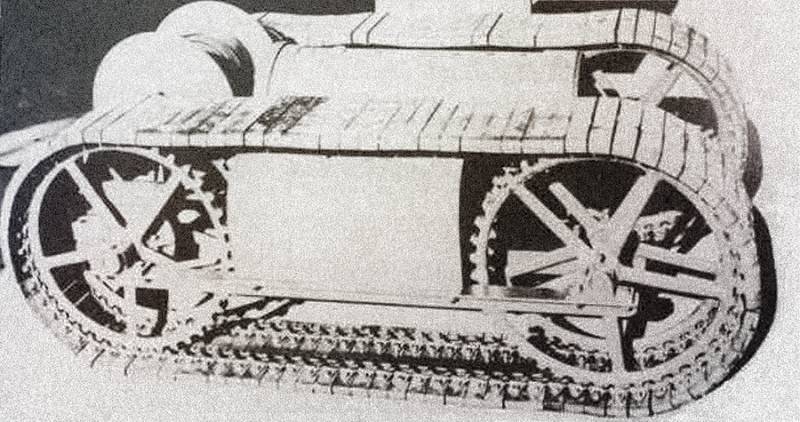
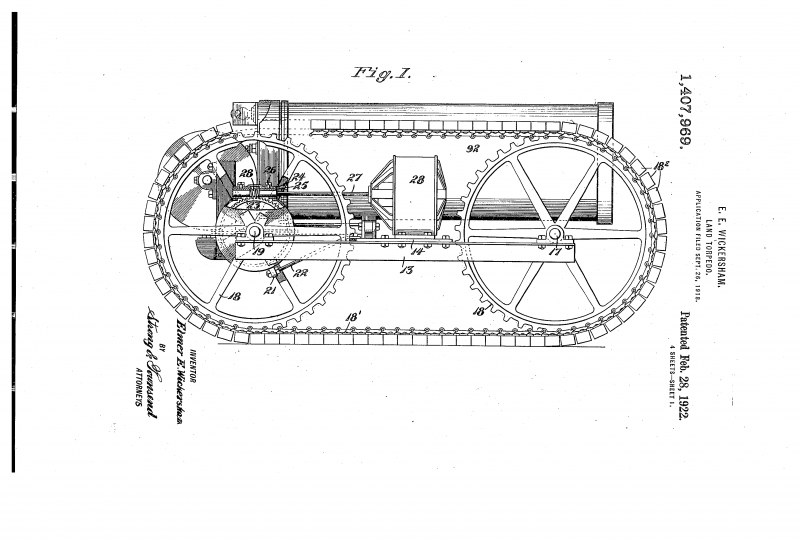
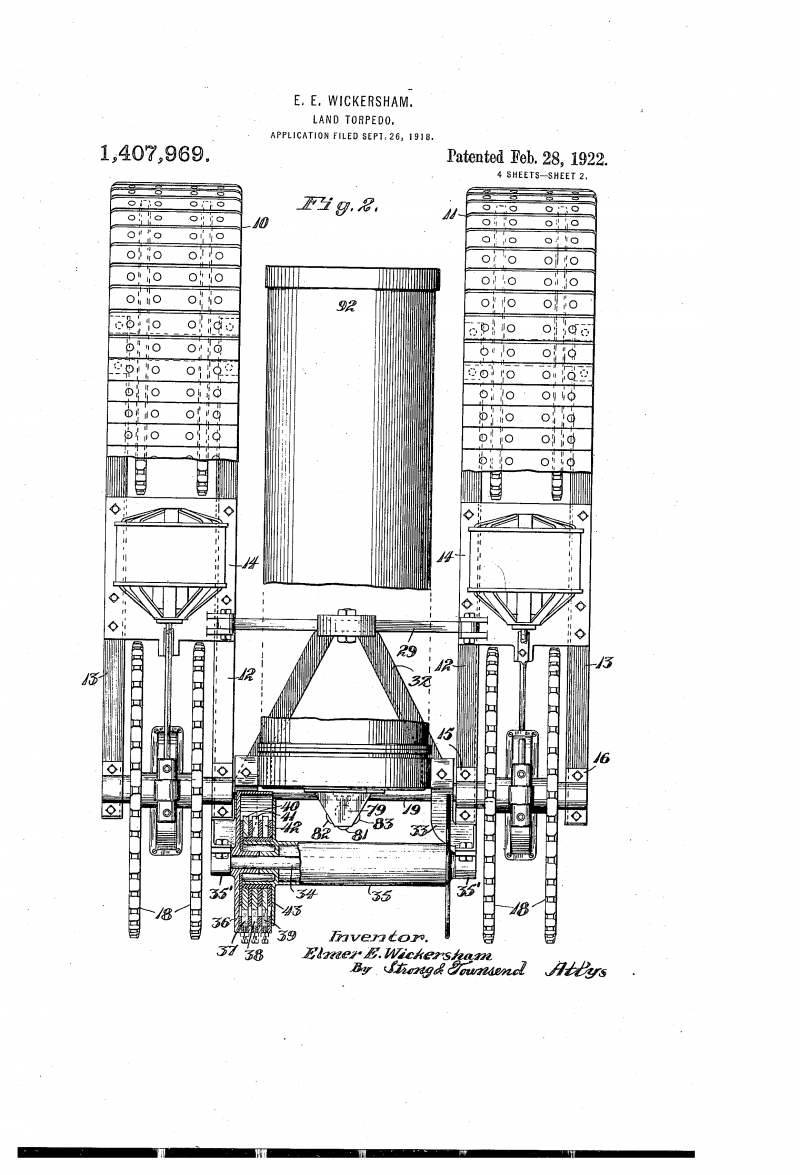
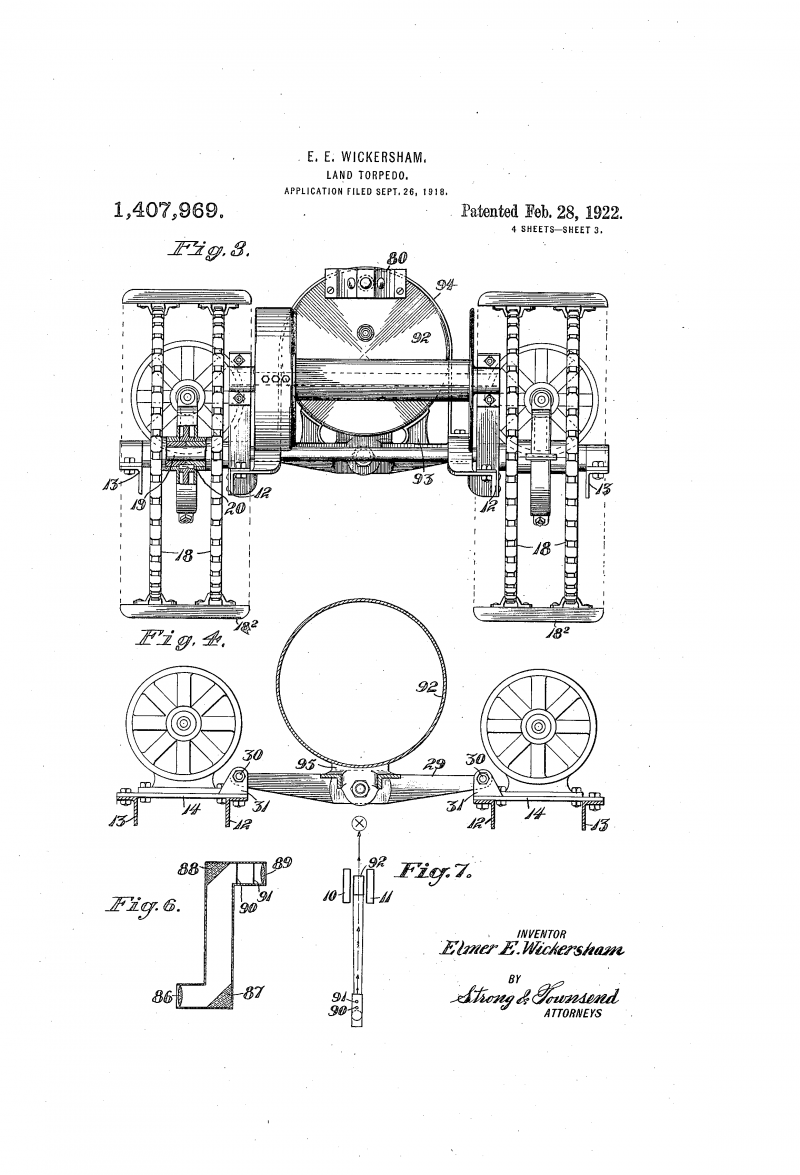
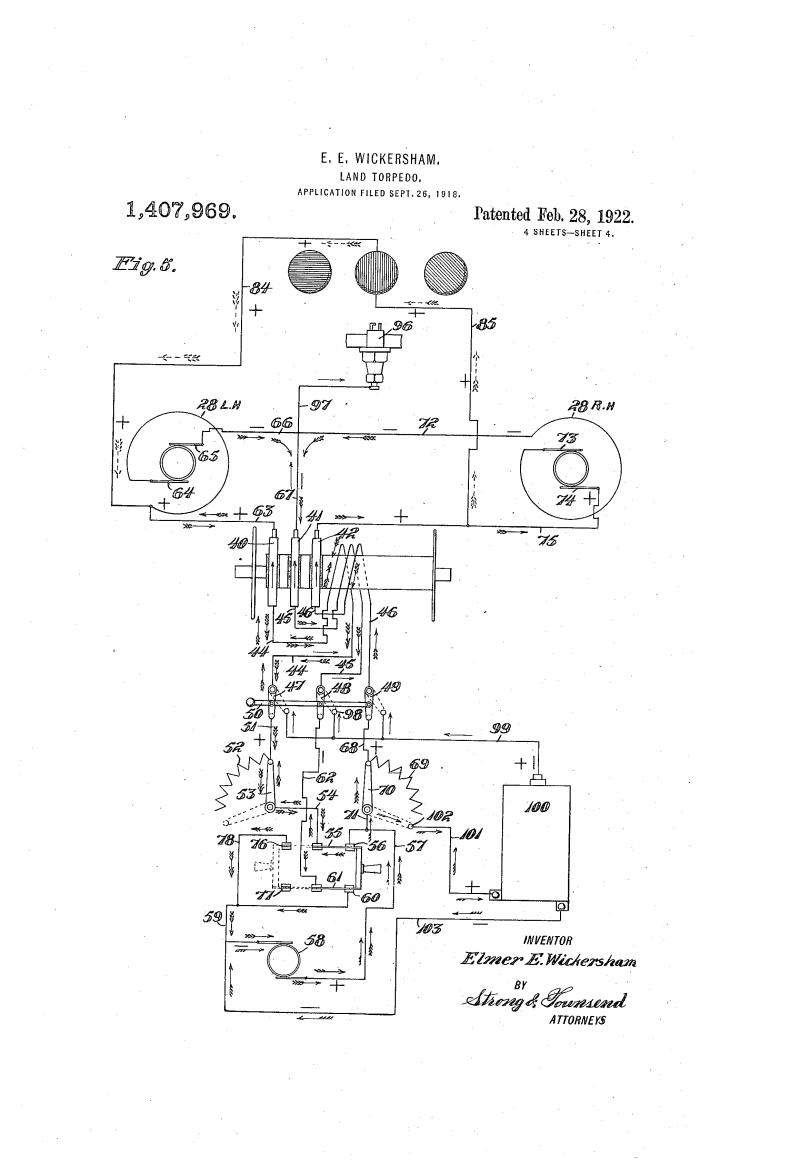
Information